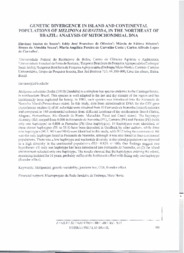Genetic divergence in island and continental populations of Melipona subnitida, in the Northeast of Brazil: analysis of mitochondrial DNA.
Genetic divergence in island and continental populations of Melipona subnitida, in the Northeast of Brazil: analysis of mitochondrial DNA.
Author(s): SOUZA, F. S. de; OLIVEIRA, E. J. F. de; RIBEIRO, M. de F.; SOUZA, B. de A.; COSTA, M. A. P. de C.; CARVALHO, C. A. L. de
Summary: Melipona subnitida Ducke (1910) (Jandaíra) is a stingless bee species endemic to the Caatinga biome, in northeastem Brazil. This species is well adapted to the hot and dry climate of the region and has traditionally been exploited for honey. In 1983, such species was introduced into the Femando de Noronha Island (Pemambuco state). In this study, data from mitochondrial DNA for the Cal gene (cytochrome oxidas e I) of M subnitida were obtained from 13 Femando de Noronha (island) colonies and compared to 160 continental colonies from different locations ofthe northeastem Brazil (Bahia, Alagoas, Pemambuco, Rio Grande do Norte, Maranhão, Piauí and Ceará states). The haplotype diversity (Hd) ranged from 0.000 in Femando de Noronha (PE), Cumaru (PE) and Passira (PE) (with only one haplotype) to 0.806 in Parnaíba (PI) (four haplotypes). 14 haplotypes were identified, of these eleven haplotypes (H 1 to H 11) have been deposited in GenBank by other authors, while three new haplotypes (H12, H13 and H14) were identified in this study, with H12 being the commonest. H4 was the only haplotype found in Femando de Noronha, although it was also found in four continental populations. There was a low haplotype and nucleotide diversity in the island populations as opposed to a high diversity in the continental populations (Hd= 0.824; n=160). Our findings suggest two hypotheses: (1) only one haplotype has been introduced into Femando de Noronha; or (2) the island environment selected only one haplotype. The results showed that the haplotypes entering the island, remaining isolated for 31 years, probably suffered the bottleneck effect with fixing only one haplotype (founder effect).
Publication year: 2015
Types of publication: Abstract in annals or event proceedings
Unit: Embrapa Semi-arid Region
Observation
Some of Embrapa's publications are published as ePub files. To read them, use or download one of the following free software options to your computer or mobile device. Android: Google Play Books; IOS: iBooks; Windows and Linux: Calibre.
Access other publications
Access the Agricultural Research Database (BDPA) to consult Embrapa's full library collection and records.
Visit Embrapa Bookstore to purchase books and other publications sold by Embrapa.

